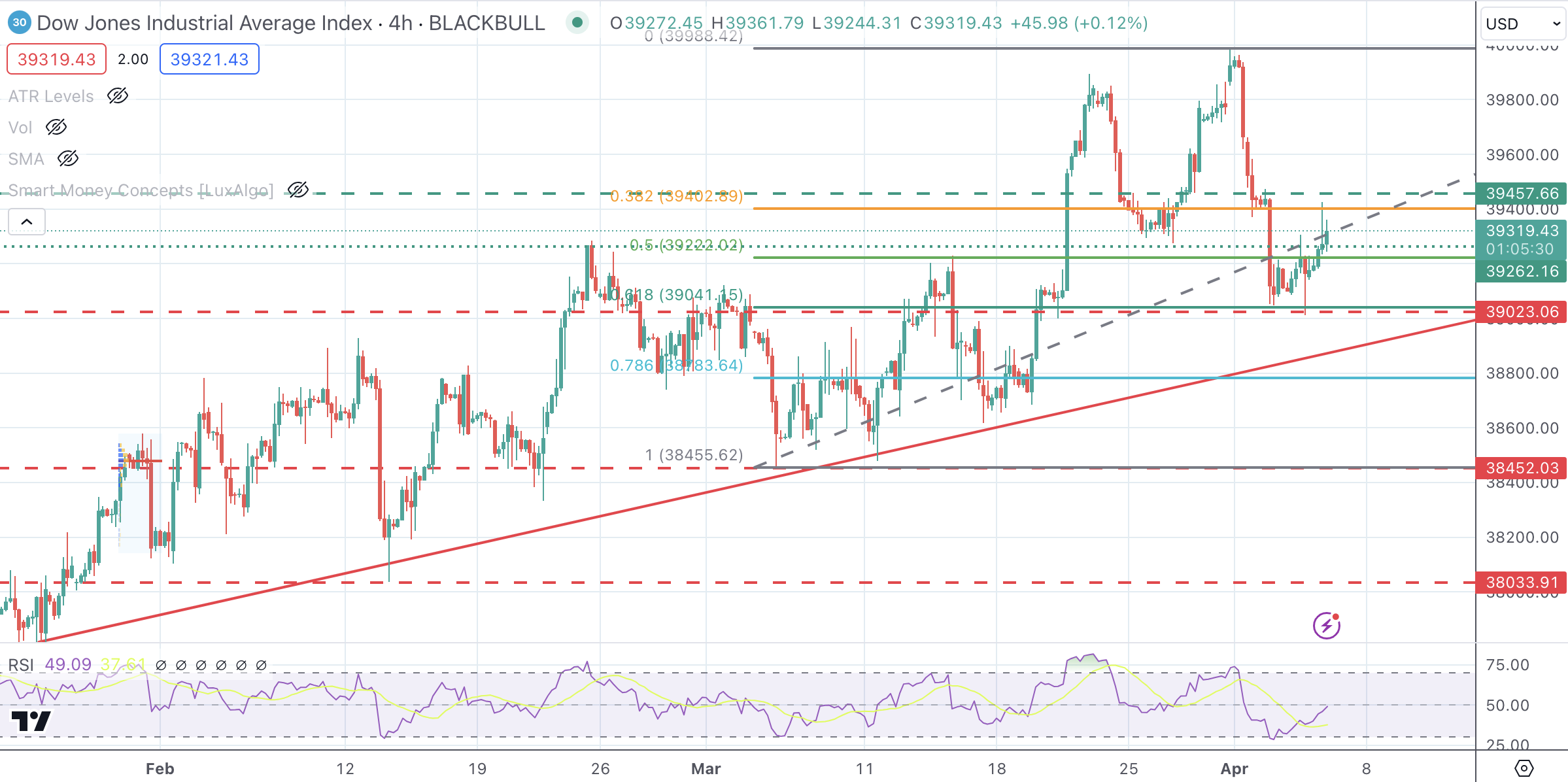- The Dow Jones maintains a moderately bullish tone on Thursday, helped by soft US jobless claims data.
- Hopes for Fed rate cuts buoy all sectors, with technology companies leading the gains.
- The index remains far from the all-time highs recorded in March, and investors remain cautious ahead of Friday's NFP report.
The Dow Jones Industrial Average (DJIA) advances for the second consecutive day, as higher-than-expected US jobless claims numbers support the forecast of three interest rate cuts in 2024, starting in June.
Jobless claims rose to their highest level in two months in the last week of March, according to data released Thursday by the Labor Department. These figures come after weak service sector activity data on Wednesday eased market fears that a strong US economy would force the Federal Reserve (Fed) to scale back its monetary easing plans.
Fed Chairman Patrick Harker reiterated Powel's warning that the central bank may need more time to begin reversing its tightening cycle, but they have failed to curb positive sentiment. Investors continue to watch Friday's US Nonfarm Payrolls (NFP) report for further clues on the outlook for rates.
All Wall Street indices record gains this Thursday. The Nasdaq leads the classification with an advance of 0.95% to 16,435 points, followed by the S&P 500, which rises 0.75% to 5,249 points, and the Dow Jones, which adds 0.5% to 39,321 points.
Dow Jones News
Positive market sentiment is buoying all 11 Wall Street sectors on Thursday, with technology stocks leading the gains, up 1.03%, on hopes of lower interest rates. They are followed by the consumer discretionary sector, with an increase of 1.02%, and the industrial sector, which rises 0.99%. The healthcare and energy sectors lag behind, with gains of 0.13% and 0.31%, respectively.
Microsoft (MSFT) is the best performing stock on the Dow Jones Index, up 1.63% to $427.39, followed by Travelers Companies (TRV), up 1.5% to $232.50. On the downside, Salesforce (CRM) falls 0.58% to $302.85, and 3M (MMM) loses 0.4% to $92.92.
Dow Jones Technical Outlook
The technical picture has improved somewhat, as improved market sentiment triggered by soft US data is contributing to a moderate recovery following the downward correction seen earlier this week.
The short-term bias remains neutral, with bullish attempts limited below the 39,457 level. The index could need additional support from dismal NFP data to revisit the 40,000 resistance zone.
The overall trend remains bullish with 39.025 closing the way to trendline support at 38.885 and the 38.435 level.
Dow Jones 4-hour chart

Employment FAQs
How do employment levels affect currencies?
Labor market conditions are a key element in assessing the health of an economy and, therefore, a key factor in the valuation of currencies. A high level of employment, or a low level of unemployment, has positive implications for consumer spending and therefore economic growth, boosting the value of the local currency. On the other hand, a very tight labor market – a situation in which there is a shortage of workers to fill vacant positions – can also have implications on inflation levels and, therefore, on monetary policy, since a supply of labor Low labor and high demand lead to higher wages.
Why is wage growth important?
The pace at which wages grow in an economy is key for policymakers. High wage growth means that households have more money to spend, which often translates into higher prices for consumer goods. Unlike more volatile sources of inflation, such as energy prices, wage growth is considered a key component of underlying and persistent inflation, as wage increases are unlikely to be undone. Central banks around the world pay close attention to wage growth data when deciding their monetary policy.
How much do central banks care about jobs?
The weight that each central bank assigns to labor market conditions depends on its objectives. Some central banks have mandates explicitly related to the labor market beyond controlling inflation levels. The United States Federal Reserve (Fed), for example, has the dual mandate of promoting maximum employment and stable prices. Meanwhile, the only mandate of the European Central Bank (ECB) is to keep inflation under control. Even so, and despite the mandates they have, labor market conditions are an important factor for the authorities given their importance as an indicator of the health of the economy and their direct relationship with inflation.
Source: Fx Street
I am Joshua Winder, a senior-level journalist and editor at World Stock Market. I specialize in covering news related to the stock market and economic trends. With more than 8 years of experience in this field, I have become an expert in financial reporting.







